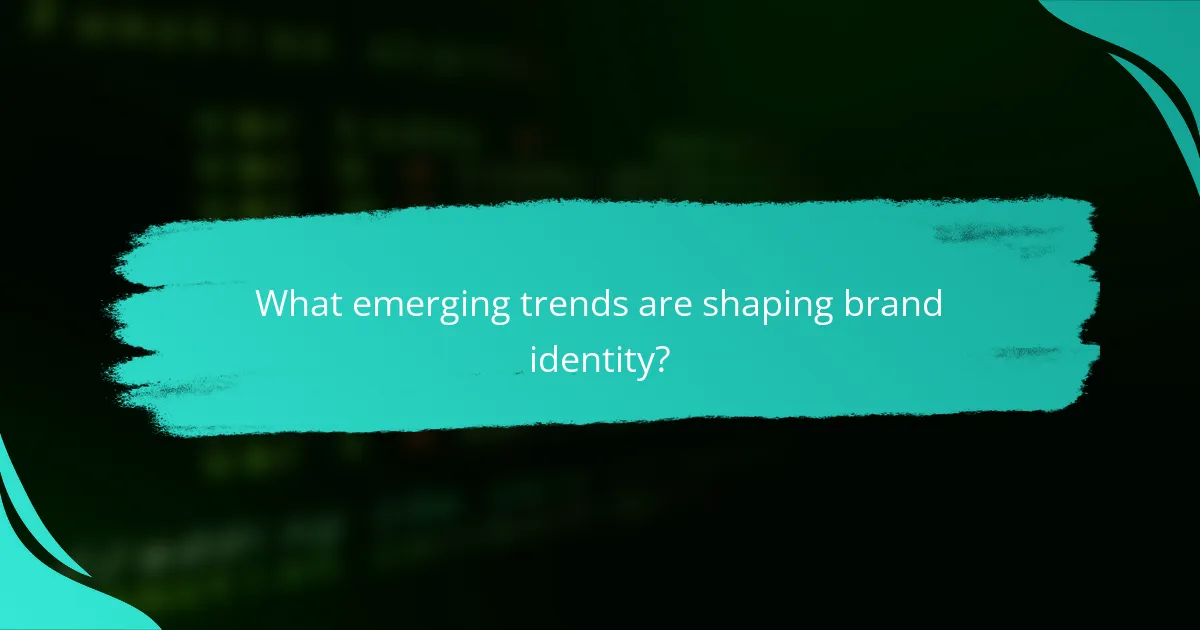Creating a strong brand identity for digital products requires a strategic focus on positioning, design, and messaging. By defining your market niche and understanding your audience, you can effectively communicate your unique value and ensure your brand stands out. Cohesive design elements, such as logos and color schemes, enhance visual representation, while clear messaging resonates with users and addresses their needs. Together, these components build a compelling brand that engages and retains customers in a competitive digital landscape.

How to position your brand for digital products?
Positioning your brand for digital products involves defining your market niche, understanding your audience, and clearly communicating your unique value. This strategic approach ensures your brand stands out in a competitive landscape and resonates with potential customers.
Market research and audience analysis
Effective market research and audience analysis are crucial for successful brand positioning. Start by identifying your target demographic, including their preferences, behaviors, and pain points. Utilize surveys, interviews, and analytics tools to gather data that informs your understanding of the market.
Consider segmenting your audience based on factors such as age, location, and purchasing habits. This segmentation allows for tailored messaging and product offerings that meet specific needs, enhancing customer engagement and loyalty.
Unique value proposition development
Your unique value proposition (UVP) articulates what sets your brand apart from competitors. It should clearly convey the benefits your digital product offers and why customers should choose you over others. A strong UVP is concise, compelling, and directly addresses customer pain points.
To develop your UVP, focus on the key features of your product and how they solve specific problems for your audience. Test different versions of your UVP with potential customers to gauge effectiveness and refine your messaging accordingly.
Competitive landscape assessment
Assessing the competitive landscape helps you understand where your brand fits within the market. Identify your main competitors and analyze their strengths and weaknesses, including their branding, product offerings, and customer engagement strategies. This analysis can reveal gaps in the market that your brand can exploit.
Use tools like SWOT analysis (Strengths, Weaknesses, Opportunities, Threats) to evaluate your position relative to competitors. Regularly revisit this assessment to adapt to market changes and ensure your brand remains relevant and competitive.

What design elements enhance brand identity?
Design elements that enhance brand identity include logos, color schemes, and typography. These components work together to create a cohesive visual representation of a brand, influencing how consumers perceive and interact with it.
Logo design and visual identity
A logo serves as the cornerstone of a brand’s visual identity, encapsulating its essence in a simple graphic. Effective logos are memorable, versatile, and relevant to the brand’s mission. Consider using unique shapes or symbols that resonate with your target audience to enhance recognition.
When designing a logo, ensure it scales well across different mediums, from digital platforms to print materials. Test variations in size and color to confirm that it remains impactful and legible in various contexts.
Color psychology and branding
Color plays a crucial role in branding, as it evokes emotions and influences consumer behavior. Different colors can convey various messages; for example, blue often represents trust, while red can evoke excitement. Choose a color palette that aligns with your brand values and resonates with your audience.
When selecting colors, consider cultural meanings and associations, especially if your brand operates in multiple regions. Conduct A/B testing to determine which color combinations yield the best engagement and conversion rates.
Typography and brand consistency
Typography is essential for maintaining brand consistency and enhancing readability. Select fonts that reflect your brand’s personality—serif fonts often convey tradition, while sans-serif fonts suggest modernity. Limit your font choices to two or three to maintain a cohesive look across all materials.
Ensure that your typography is legible across different devices and sizes. Establish a hierarchy with font sizes and weights to guide readers’ attention effectively. Consistency in typography reinforces brand identity and helps build trust with your audience.

How to craft effective messaging for digital products?
Effective messaging for digital products involves clear communication that resonates with the target audience and aligns with the brand’s identity. It should convey the product’s value proposition, addressing the needs and pain points of users while maintaining consistency across all platforms.
Brand voice and tone definition
Brand voice refers to the distinct personality and style of communication that a brand uses to connect with its audience. Tone, on the other hand, can vary depending on the context and audience, adapting the brand voice to suit different situations while maintaining overall consistency.
To define your brand voice and tone, consider your target audience’s preferences and the emotions you want to evoke. For instance, a tech startup might adopt a friendly and innovative tone, while a financial institution may choose a more formal and authoritative voice.
Key messaging frameworks
Key messaging frameworks help structure your communication to ensure clarity and impact. Common frameworks include the Problem-Agitate-Solution (PAS) model, which identifies a problem, highlights its implications, and presents your product as the solution.
Another effective framework is the Value Proposition Canvas, which aligns your product’s features with the specific needs and desires of your audience. This approach ensures that your messaging is relevant and compelling, increasing the likelihood of engagement and conversion.
Storytelling techniques for engagement
Storytelling techniques can significantly enhance engagement by making your messaging relatable and memorable. Using narratives that include characters, challenges, and resolutions can help illustrate how your digital product solves real-world problems.
Incorporate elements like customer testimonials or case studies to provide authenticity and relatability. For example, sharing a story about how a user improved their workflow with your software can create a strong emotional connection with potential customers.

What are the best practices for brand identity in the digital space?
Best practices for brand identity in the digital space focus on creating a cohesive and recognizable presence across various platforms. This includes consistent design elements, clear messaging, and a user-friendly experience that aligns with the brand’s values and target audience.
Responsive design considerations
Responsive design is crucial for ensuring that a brand’s identity is maintained across different devices and screen sizes. This means creating flexible layouts that adapt to various resolutions, ensuring that logos, colors, and typography remain consistent and visually appealing.
When designing for responsiveness, consider using fluid grids and scalable images. Test your designs on multiple devices to identify any inconsistencies and make adjustments as needed. Aim for a seamless experience, as a poorly rendered site can negatively impact brand perception.
User experience and brand perception
User experience (UX) significantly influences brand perception in the digital realm. A well-designed interface that is intuitive and easy to navigate enhances user satisfaction and fosters a positive association with the brand. Prioritize usability to ensure that users can easily access information and complete tasks.
To improve UX, conduct user testing and gather feedback to identify pain points. Implement design elements that reflect the brand’s personality, such as color schemes and typography, to create an emotional connection with users. Remember that a positive experience can lead to increased loyalty and advocacy for the brand.

How to measure brand identity effectiveness?
Measuring brand identity effectiveness involves evaluating how well your brand is recognized, perceived, and valued by your target audience. Key metrics include brand awareness, customer feedback, and engagement levels, which together provide insights into your brand’s positioning and messaging impact.
Brand awareness metrics
Brand awareness metrics assess how familiar consumers are with your brand. Common indicators include brand recall, recognition rates, and search volume. For instance, tracking the percentage of your target audience that can identify your brand after seeing it in advertisements can provide a clear picture of your brand’s visibility.
Tools like Google Trends and social media analytics can help measure these metrics. Aim for a consistent increase in awareness over time, ideally targeting a growth rate of several percentage points each quarter.
Customer feedback and surveys
Customer feedback and surveys are essential for understanding perceptions of your brand identity. Regularly collecting insights through tools like online surveys or focus groups can reveal how well your messaging resonates with your audience. Aim for a response rate of around 10-20% for meaningful results.
Consider using Net Promoter Score (NPS) or Customer Satisfaction Score (CSAT) to quantify customer sentiment. These metrics can help identify strengths and weaknesses in your brand identity, guiding adjustments to your positioning and messaging strategies.

What frameworks can guide brand identity development?
Several frameworks can effectively guide brand identity development, helping businesses articulate their positioning, design, and messaging. Utilizing models like the brand identity prism and SWOT analysis can provide structured approaches to defining and refining a brand’s identity.
Brand identity prism model
The brand identity prism model is a visual framework that outlines six key facets of a brand’s identity: physique, personality, culture, relationship, reflection, and self-image. This model helps brands understand how they are perceived and how they wish to be perceived by their audience.
To apply the brand identity prism, start by defining each facet. For example, consider your brand’s physical attributes (physique), the traits you want to convey (personality), and the values that drive your organization (culture). This holistic view ensures consistency across all brand touchpoints.
SWOT analysis for branding
SWOT analysis is a strategic planning tool that evaluates a brand’s Strengths, Weaknesses, Opportunities, and Threats. This analysis helps brands identify internal and external factors that can influence their identity and market positioning.
Conducting a SWOT analysis involves listing strengths such as unique features or loyal customer bases, weaknesses like limited resources, opportunities in emerging markets, and threats from competitors. This structured approach allows brands to leverage their strengths and address weaknesses while navigating market challenges.

What emerging trends are shaping brand identity?
Emerging trends in brand identity are increasingly influenced by technology, consumer behavior, and the demand for authenticity. Brands are focusing on personalization, sustainability, and digital engagement to create a unique identity that resonates with their target audience.
Personalization in digital branding
Personalization in digital branding involves tailoring experiences and messages to individual users based on their preferences and behaviors. This trend is driven by advancements in data analytics and artificial intelligence, allowing brands to create more relevant interactions.
To effectively implement personalization, brands should collect and analyze user data while respecting privacy regulations such as GDPR. Techniques can include personalized email campaigns, targeted advertisements, and customized website experiences that adapt to user behavior.
For example, e-commerce platforms often use browsing history to recommend products, enhancing user engagement and increasing conversion rates. Brands should avoid over-personalization, which can lead to privacy concerns or alienate users if they feel their data is being misused.
